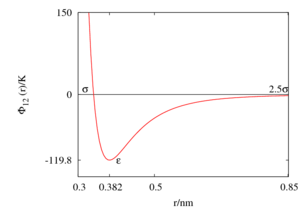Argon: Difference between revisions
Jump to navigation
Jump to search
Carl McBride (talk | contribs) m (Added a quantum paper.) |
(Reference to Aziz's potential) |
||
| Line 1: | Line 1: | ||
[[Image:Lennard-Jones.png|thumb| The Lennard-Jones model for argon.]] | [[Image:Lennard-Jones.png|thumb| The Lennard-Jones model for argon.]] | ||
'''Argon''' has a mass of 39.948 [[atomic mass units | umas]]. Sadus and Prausnitz have shown that three-body repulsion makes a significant contribution to [[Idealised models#Three-body potentials|three-body interactions]] in the liquid phase (Ref. 4) (for use of the [[Axilrod-Teller interaction]] see Refs. 5 and 6). However, the [[Lennard-Jones model]] has been frequently used due to its simplicity. | '''Argon''' has a mass of 39.948 [[atomic mass units | umas]]. Sadus and Prausnitz have shown that three-body repulsion makes a significant contribution to [[Idealised models#Three-body potentials|three-body interactions]] in the liquid phase (Ref. 4) (for use of the [[Axilrod-Teller interaction]] see Refs. 5 and 6). However, the generic [[Lennard-Jones model]] has been frequently used due to its simplicity; some parameters are quoted in the next section. A specific interatomic potential for Ar has been proposed by Aziz (Ref. 10). | ||
==Lennard-Jones parameters== | ==Lennard-Jones parameters== | ||
The [[Lennard-Jones model |Lennard-Jones]] parameters for liquid argon are listed in the following table: | The [[Lennard-Jones model |Lennard-Jones]] parameters for liquid argon are listed in the following table: | ||
| Line 28: | Line 28: | ||
#[http://dx.doi.org/10.1080/00268977100101821 J. A. Barker, R. A. Fisher and R. O. Watts "Liquid argon: Monte carlo and molecular dynamics calculations", Molecular Physics '''21''' pp. 657-673 (1971)] | #[http://dx.doi.org/10.1080/00268977100101821 J. A. Barker, R. A. Fisher and R. O. Watts "Liquid argon: Monte carlo and molecular dynamics calculations", Molecular Physics '''21''' pp. 657-673 (1971)] | ||
#[http://dx.doi.org/10.1063/1.479848 John A. White "Lennard-Jones as a model for argon and test of extended renormalization group calculations", Journal of Chemical Physics '''111''' pp. 9352-9356 (1999)] | #[http://dx.doi.org/10.1063/1.479848 John A. White "Lennard-Jones as a model for argon and test of extended renormalization group calculations", Journal of Chemical Physics '''111''' pp. 9352-9356 (1999)] | ||
#[http://dx.doi.org/10.1063/1.466051 Ronald A. Aziz "A highly accurate interatomic potential for argon", Journal of Chemical Physics '''99''' p. 4518 (1993)] | |||
[[category: models]] | [[category: models]] | ||
{{Numeric}} | {{Numeric}} | ||
Revision as of 13:29, 1 April 2009

Argon has a mass of 39.948 umas. Sadus and Prausnitz have shown that three-body repulsion makes a significant contribution to three-body interactions in the liquid phase (Ref. 4) (for use of the Axilrod-Teller interaction see Refs. 5 and 6). However, the generic Lennard-Jones model has been frequently used due to its simplicity; some parameters are quoted in the next section. A specific interatomic potential for Ar has been proposed by Aziz (Ref. 10).
Lennard-Jones parameters
The Lennard-Jones parameters for liquid argon are listed in the following table:
| Authors | (K) | (nm) | Reference |
| Rowley, Nicholson and Parsonage | 119.8 | 0.3405 | Ref. 7 |
| Barker, Fisher and Watts | 142.095 | 0.33605 | Ref. 8 |
| White | 125.7 | 0.3345 | Ref. 9 parameter set #4 |
Radial distribution function
Quantum simulations
References
- H. C. Longuet-Higgins and B. Widom "A rigid sphere model for the melting of argon", Molecular Physics 8 pp. 549-556 (1964)
- D. Henderson and J. A. Barker "On the solidification of argon", Molecular Physics 14 pp. 587-589 (1968)
- F. Lado "Numerical Calculation of the Density Autocorrelation Function for Liquid Argon", Physical Review A 5 pp. 2238-2244 (1972)
- Richard J. Sadus and J. M. Prausnitz "Three-body interactions in fluids from molecular simulation: Vapor–liquid phase coexistence of argon", Journal of Chemical Physics 104 pp. 4784-4787 (1996)
- Phil Attard "Pair-hypernetted-chain closure for three-body potentials: Results for argon with the Axilrod-Teller triple-dipole potential", Physical Review A 45 pp. 3659-3669 (1992)
- J. A. Anta, E. Lomba and M. Lombardero "Influence of three-body forces on the gas-liquid coexistence of simple fluids: The phase equilibrium of argon", Physical Review E 55 pp. 2707-2712 (1997)
- L. A. Rowley, D. Nicholson and N. G. Parsonage "Monte Carlo grand canonical ensemble calculation in a gas-liquid transition region for 12-6 Argon", Journal of Computational Physics 17 pp. 401-414 (1975)
- J. A. Barker, R. A. Fisher and R. O. Watts "Liquid argon: Monte carlo and molecular dynamics calculations", Molecular Physics 21 pp. 657-673 (1971)
- John A. White "Lennard-Jones as a model for argon and test of extended renormalization group calculations", Journal of Chemical Physics 111 pp. 9352-9356 (1999)
- Ronald A. Aziz "A highly accurate interatomic potential for argon", Journal of Chemical Physics 99 p. 4518 (1993)

